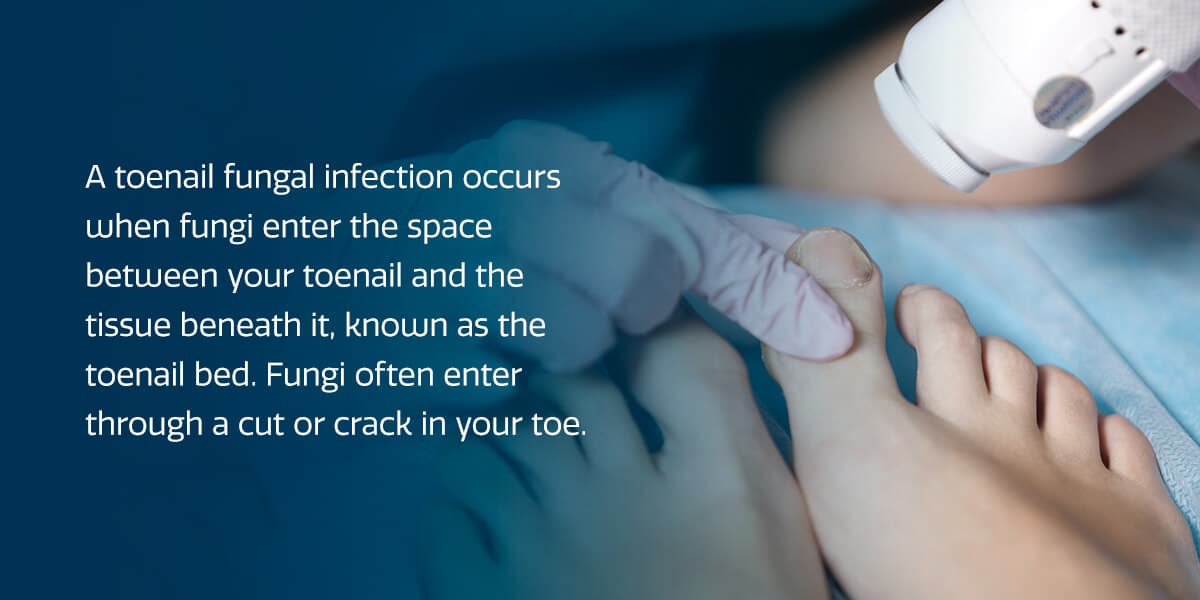A toenail fungus is a fungal infection underneath the surface of your toenail. These infections may not be painful, but they can make your toenail unsightly enough that you want to hide your feet in embarrassment. Luckily, you don’t have to live with foot and toenail fungus that lead to unpleasant symptoms in your feet and ankles.
There are many ways to prevent toenail infections from happening in the first place. But if you do develop one, you could try using a home remedy for toenail fungus to effectively treat them. We’ll cover the prevention and treatment of toenail fungal infections here, as well as when you may need to see a doctor.
Symptoms of Toenail Fungus
Many people ask whether toenail fungus can be painful or not. The answer is that it depends. Toenail fungus may cause any or all of the following symptoms:
- Discolored nails — white, yellow, green, brown, black, cloudy or chalky
- Thickened nails
- Weak, crumbly or jagged nails
- Cracked nails
- Misshapen nails
- Nails that separate from the nailbed
- Smelly nails

What Causes Toenail Fungus?
A toenail fungal infection occurs when fungi enter the space between your toenail and the tissue beneath it, known as the toenail bed. Fungi often enter through a cut or crack in your toe. Various types of fungi, as well as molds, bacteria and yeast, can cause a toenail infection.
Athlete’s foot or tinea pedis is a fungal infection of the skin on the foot that usually begins between the toes and can spread to the toenail. Likewise, a toenail fungal infection can spread to the skin of the foot and cause athlete’s foot.
One fungus that commonly causes toenail fungal infections is called a dermatophyte. Dermatophytes are molds that need keratin to thrive. Dermatophytes are drawn to toenails because keratin is their main structural protein. When dermatophytes cause toenail fungus, the condition is known as tinea unguium.
Who Does Toenail Fungus Affect?
Toenail fungus is a common condition that can affect anyone. However, it’s especially prevalent in adults over 60. The following conditions and situations can put you at a greater risk of developing toenail fungus:
- A nail injury
- Athlete’s foot
- Hyperhidrosis, a condition that causes excessive sweating
- Walking barefoot in a damp public place
- Wearing shoes that cause your feet to sweat heavily
- Psoriasis
- Diabetes
- Poor blood circulation, such as from peripheral vascular disease
- A weakened immune system, such as from an autoimmune disease
Treatments for Toenail Fungus in Your Foot
Toenail fungus is usually not serious and may be treatable at home. Using essential oils for foot fungus is a popular homeopathic method of treatment. The following remedies may be helpful in clearing up your toenail fungus.
- Tea tree oil: Also known as melaleuca, tea tree oil has antifungal and antiseptic properties. Apply it to the affected toenail with a cotton swab twice daily.
- Oregano oil: Oregano oil contains thymol, a plant-based derivative with antifungal and antiseptic properties. Apply oregano oil to your infected toenail twice daily with a cotton swab.
- Vicks VapoRub: The camphor and eucalyptus oil in this topical ointment may help treat toenail fungus. Apply the ointment directly to your toenail daily.
- Snakeroot extract: Snakeroot extract is an antifungal that comes from sunflowers and related plants. It comes in a liquid that you can apply directly on the nail or to a piece of gauze to wrap around it.
- Listerine: The menthol, eucalyptus and thymol in Listerine mouthwash have fungus-fighting abilities. To treat toenail fungus, soak the affected toe in a bowl of Listerine for 30 minutes daily.
- Vinegar: The antifungal and antibacterial properties in vinegar can hinder fungi growth and skin infections. Soak the infected toe in a vinegar solution for up to 20 minutes daily.
- Olive leaf extract: Oleuropein is a substance in olive leaf extract thought to have antifungal abilities. You can take olive leaf extract in capsule form or apply it directly to the toenail in salve form.
- Garlic: Garlic has antifungal capabilities. You can take garlic capsules or apply crushed cloves to the affected toenail for 30 minutes daily.
- Diet: Eating a nutritious diet is an essential component of overall health. Foods rich in protein, iron, fatty acids, vitamin D and probiotics can help keep your nails healthy.
- Ozonized oils: Ozonized oils, such as olive and sunflower oil, are injected with ozone gas, which can disable infection-causing fungi. You can rub ozonized oils directly into the infected toenail twice daily.
How to Prevent Toenail Fungus in Your Foot
There are many strategies you can use to help avoid toenail fungus and athlete’s foot:
- Keep your toenails dry and clean.
- Wash your hands after touching an infected toenail.
- Trim your toenails regularly, cutting them straight across and smoothing the edges with a nail file. Clean your toenail trimmers after each use.
- Apply a nail hardener, which can strengthen nails and cuticles.
- Wear lightweight socks and change them throughout the day if your feet become sweaty.
- Wear shoes made of breathable materials.
- Treat shoes with antifungal powders or disinfectants to keep pathogens at bay.
- Wear shoes in damp public areas like pools, gyms, shower rooms and saunas.
- If you visit a nail salon, choose one that sterilizes its tools for each patron.
- Avoid artificial nails and nail polish.
- Treat athlete’s foot with an antifungal product.
When to See a Doctor for Toenail Fungus
It’s a good idea to seek professional care for your toenail fungus if home remedies are not effective and you notice the following:
- The toenail becomes increasingly thick, discolored or misshapen
- The toe becomes swollen, red, tender or warm to the touch
- The toe begins to leak pus
- Red streaks surrounding the infected toe
- You develop a fever of 100.4 or higher
- Pain becomes intolerable
You should also contact your doctor if you have a toenail fungus and:
- Diabetes
- Bleeding around the nail
- Swelling or discomfort around the nail
- Trouble walking
A severely infected toenail can cause pain and permanent nail damage. If you have a weak immune system due to autoimmune disorders, diabetes, medication or other conditions, a toenail fungal infection can spread beyond your feet and lead to other serious infections.
Your doctor may treat your toenail fungus with oral antifungal medications or topical treatments like antifungal nail polish or medicated nail cream. In extreme cases, doctors can surgically remove the toenail and apply medications directly to the nailbed.
Get Care for Toenail Fungus at Foot & Ankle Surgical Associates
The good news is that you don’t have to live with an unsightly toenail fungus. If home remedies and treatments for toenail fungus don’t clear up your infection, the Foot & Ankle Surgical Associates team can help. We treat foot and ankle injuries and conditions in people of all ages to help them return to the life they deserve.
Call us at 360-754-3338 or fill out a contact form to speak with us about your foot or ankle condition. We can’t wait to help you put your best foot forward.






